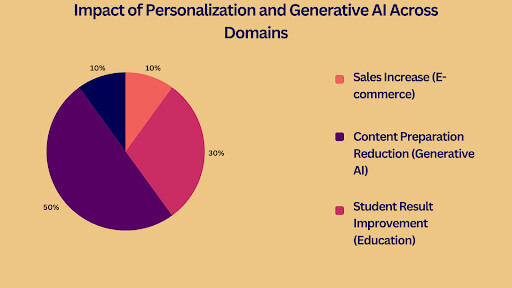 1-800-805-5783
1-800-805-5783 
Generative AI is now so strong that it can enhance content personalization and recommendation systems. Using Generative AI to create new, high-quality content helps offer more relevant and engaging user experiences.
What is content personalization? Personalized content is one of the major concerns for consumers in this modern information era. Personalization entails creating content to meet users’ needs, interests, and preferences. Recommendation systems are essential in personalizing content by suggesting items or experiences relevant to a user’s previous behavior and preferences.
Facts & Figures
While technology continues to evolve, there are increasing expectations for more sophisticated and productive personalization methods and recommendations. This blog post looks at generative AI and how it can enhance such systems and offer users better online experiences.

One type of artificial intelligence is generative AI, which creates new content, like text, images, audio, and video, by training large datasets of existing content through an AI model. The resulting models can generate new content in the same style and with the same substance as the training data.
Some of the fundamental techniques that are being put into work in generative AI are:
Generative Adversarial Networks (GANs): GANs consist of two neural networks, a generator and a discriminator, that compete to produce realistic content.
Variational Autoencoders: VAEs generate new data probabilistically by learning a latent representation of input data.
Transformer models: These models are especially good at text generation and have been used to develop some of the most potent modern language models, including GPT-3.
Importance of Content Personalization and Recommendation Systems
Content personalization and recommendations have several benefits, both for users and businesses. Personalized content can enhance users’ online experience since the results become more relevant and exciting. Companies can enjoy more significant customer satisfaction, loyalty, and sales with customized content.
Key benefits of content personalization and recommendation systems include:
How Generative AI Can Improve These Systems
Generative AI is a niche technology that has significantly improved content personalization and recommendation systems by creating more relevant and engaging content. Following are some ways generative AI can be put to work to improve these systems:
Content Generation-Personalised: With generative AI, personalized articles, blog entries, product descriptions, and a plethora of other material types to the unique interests and preferences of each user.
Improvement in Recommendation Algorithm: Generative AI allows for more profound development in recommendation algorithms, enabling them to propose pertinent content and comprehend user preferences more easily.
Creation of new formats: Generative AI can create new, innovative content formats, such as personalized videos, interactive quizzes, and virtual reality experiences.
Data and Statistics: Personalization of content: In research done by McKinsey, through generative AI, personalized content was created that was up to 10 times more relevant than generic content.
Recommendation algorithms: Forrester finds that generative AI can improve the precision of recommendation systems by up to 20%. By exploiting the power of generative AI, businesses may improve customer satisfaction, loyalty, and sales by providing more engaging and individualized customer experiences.

While traditional content personalization methods have shown some success, they often face several limitations:
Generative AI for content personalization has several advantages over traditional content personalization methods. It doesn’t just create new, personalized content; it does so in real-time, instantly adapting to user preferences and behavior.
According to a Netflix study, generative AI-powered recommendations can boost accuracy by up to 10%. In generative AI, rich patterns and relationships within user data are learned, improving recommendation accuracy.
Improved User Engagement: Generative AI will heighten users’ satisfaction and retention by offering highly relevant and engaging content. Large datasets can be used to train generative AI models, which can then be scaled for millions of users. —A study by Adobe says that personalizing content can increase engagement by up to 15%.
Several companies have implemented generative AI to personalize content and recommendation systems. Some examples are as follows:
Using generative AI in business processes has completely transformed how businesses interact with customers.

Recommendation systems have become a core part of our digital lives, suggesting products, services, or content that may best suit a given individual’s tastes and preferences. While traditional techniques have long included collaborative and content-based filtering, recent breakthroughs in generative AI have opened new frontiers in the accuracy of recommendations and personalization.
Collaborative Filtering vs. Content-Based Filtering
The collaborative filtering method recommends items because users are similar. This technique assumes that users like similar items, provided they have similar tastes or preferences. This technique is often used for social recommendation systems, where users tend to interact with each other.
As per Netflix, recommendations can be made up to 10% more accurately using collaborative filtering. Content-based filtering allows Amazon to raise click-through rates by up to 15%. Content-based filtering recommends items similar to what the user liked or disliked earlier. It requires metadata about the items, such as genre, keywords, or features. Content-based filtering is typically applied in product recommendation systems.
Role of Generative AI in Recommendation Improvement
Generative AI can contribute along several axes toward recommendation systems, including but not limited to the following:
Content generation: The models generate new content, given a user’s preference, which opens up the recommendation space even more for enhanced recommendations.
Improvement of item representations: Generative AI plays a crucial role in enhancing the accuracy and informativeness of item representations. Learning complex item data patterns and relationships instills confidence in the accuracy of the recommendations, thereby reassuring the audience.
Solving the cold-start problem: Generative AI models recommend new users with little historical information by considering related users or items.
Solving sparsity in data: When much partial information is available about either of the entities, that is, users or items, generative AI generates non-existing data or features.
Better item representations: According to Amazon, a study found that generative AI recommendation systems improved accuracy by up to 20%.
Hybrid Approaches Combining Generative AI with Traditional Methods
In most cases, the best results can be achieved with hybrid approaches, including generative AI and traditional methods. For example, consider the case of generative AI creating new content and recommending that content using either collaborative filtering or content-based filtering techniques.
Alternatively, generative AI could be used to develop more accurate item embeddings that can be used in concert with most traditional recommendation algorithms.
Hybrid approaches: Netflix has identified, in a study, that hybrid approaches combining the collaborative filtering method with generative AI could raise recommendation accuracy by as much as 25%. By leveraging the power of generative AI, such as movie or book recommendations, recommendation systems can be more personalized and accurate, offering users a far more enjoyable and satisfying online experience.

While personalized content and recommendation systems bring significant value, they also present numerous ethical issues and challenges. Some studies have shown AI systems are prejudiced based on one’s gender, race, and even socioeconomic status.
These must be addressed to ensure such systems’ responsible development and use, with ethics at the forefront. This underscores the importance of your role in this field.
Bias in Generative AI Models
One of the significant ethical questions with generative AI involves bias in the models that create personalized content. For instance, if biased data is utilized to train such models, the generated content will also be prejudiced. The result can be discriminatory or even hazardous recommendations.
Privacy Concerns
Content personalization and recommendation systems depend on gathering and analyzing user data. In this respect, such methods are a number one target for criticism touching upon privacy concerns since users might feel anxious about the amount of personal information gathered and what happens afterward with this information.
Data collection is one thing, but research recently conducted by the Pew Research Center found that 80% of Americans consider there to be some threat associated with personal data based on company collection and usage.
Laws on Privacy: Most governments worldwide are enforcing strict privacy regulations. These include the California Consumer Privacy Act in the United States and the General Data Protection Regulation in the European Union.
Satisfaction and Engaging the Users
The rapid development and growth of personalized content recommendation systems involving user satisfaction and engagement require urgent focus. This can be achieved by a cautious balancing act between serving relevant and engaging content while respecting user privacy and ensuring the absence of bias.
Engagement: Personalized email campaigns, according to a study done by Epsilon, can yield up to 18 times more revenue compared to non-personalized campaigns.
Generative AI is still evolving in this area, and in the coming years, we will see a significant improvement in its capability and applications. This effect will be revolutionary for content personalization software and recommendation systems, opening new frontiers of opportunities for businesses and users.
Advancements in Generative AI Technology
Future of Generative AI Models: The next generation of generative AI models will be enhanced with more sophisticated architectures and techniques, such as deep reinforcement learning and hybrid approaches.
Better Data Efficiency: Generative AI models will become much better at learning from smaller datasets and, therefore, more accessible to businesses of any size.
Multimodality: The capacity to produce and comprehend information in various media, including text, graphics, and audio.
Ethical considerations: As generative AI becomes more powerful, ethical concerns regarding bias, privacy, and intellectual property will increasingly need to be addressed.
E-commerce generative AI would work to generate personalized product recommendations, generate product descriptions, and even design bespoke products; education would create customized learning experiences, generate educational content, and tutor students; and healthcare would develop personalized treatment plans, design new drugs, and analyze medical images.
Entertainment: Generative AI opens up a world of creative possibilities. It allows for the development of exclusive, unique content for movies, television series, and games, sparking excitement in the industry.
E-commerce: With personalized recommendations on products, sales rise as much as 10% alone, according to the McKinsey study.
Education: According to a study, personalized learning has seen results from students as high as 30%.
Healthcare: “Generative AI can develop new drugs 20 times faster than traditional methods”, IBM reports.
The Impact of Generative AI on Content Creation and Consumption
Generative AI may change how content is created and consumed. According to a recent study conducted by McKinsey, generative AI can reduce the preparation of content by up to 50%. Because generative AI automates much of the work, this will allow human creatives to spend more time thinking creatively and strategically, which also implies that generative AI enables highly tailored content created to meet the needs and interests of a given user.

Generative AI has emerged as a significant enabler of better personalization and recommendation systems. Generative AI overcomes many drawbacks of conventional techniques, enabling more customized, engaging, and relevant user experiences.
The generative AI technology keeps improving, and one can only expect more innovative applications- from e-commerce to healthcare. Companies can use generative AI to compete, manage customer experience, and drive growth.
1) How can generative AI improve content personalization?
Creating dynamic, personalized content on the fly, improving recommendation accuracy, and enhancing user engagement.
2) What are the challenges in using generative AI for personalization?
Ensure the quality and relevance of generated content, address ethical concerns such as bias, and manage computational costs.
3) What are some examples of successful implementations?
Netflix, Spotify, and Amazon have used generative AI to improve content personalization and recommendation systems.
4) What are the future trends in generative AI for personalization?
Advancements in model architectures, enhanced data efficiency, multimodal capabilities, and ethical considerations.
[x]cube has been AI-native from the beginning, and we’ve been working with various versions of AI tech for over a decade. For example, we’ve been working with Bert and GPT’s developer interface even before the public release of ChatGPT.
One of our initiatives has significantly improved the OCR scan rate for a complex extraction project. We’ve also been using Gen AI for projects ranging from object recognition to prediction improvement and chat-based interfaces.
Interested in transforming your business with generative AI? Talk to our experts over a FREE consultation today!